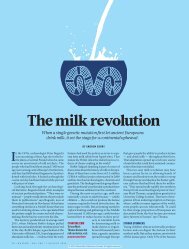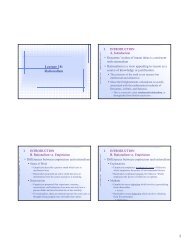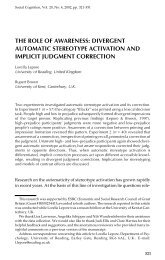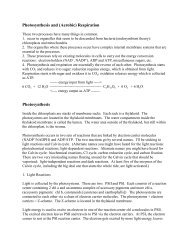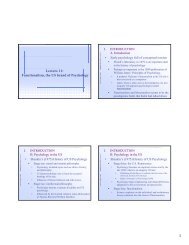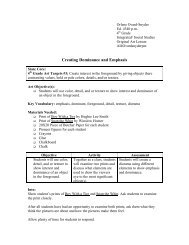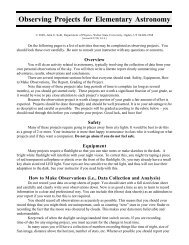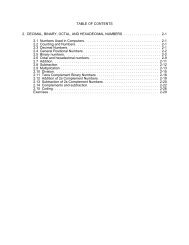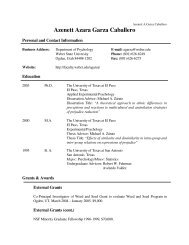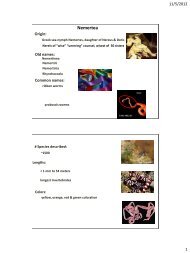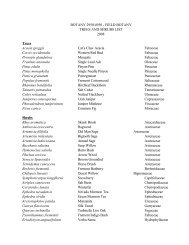Why do almost all mammals have seven cervical vertebrae ...
Why do almost all mammals have seven cervical vertebrae ...
Why do almost all mammals have seven cervical vertebrae ...
Create successful ePaper yourself
Turn your PDF publications into a flip-book with our unique Google optimized e-Paper software.
24 F. GALIS<br />
sought (1) in a genetic link between early childhood<br />
cancer and stillbirths and variation in <strong>cervical</strong><br />
<strong>vertebrae</strong> number, and (2) in the neuronal<br />
problems leading to the thoracic outlet syndrome<br />
in adults associated with <strong>cervical</strong> ribs. The involvement<br />
of Hox genes in the cancers that are<br />
associated with <strong>cervical</strong> ribs in mice and men<br />
points to a coupling between functions of Hox<br />
genes that appears to be lacking in birds, reptiles,<br />
and amphibians, or at least has no apparent consequences<br />
when <strong>cervical</strong> vertebral number is<br />
changed. There are two possible explanations for<br />
the observed coupling in <strong>mammals</strong>: (1) the coupling<br />
of functions of Hox genes has newly appeared<br />
in <strong>mammals</strong> due to a change in the<br />
functioning of Hox genes (e.g., a new function in<br />
proliferation in <strong>mammals</strong>); and (2) the coupling<br />
of functions was already present in reptiles, but<br />
hidden because of the low susceptibility to cancer.<br />
This coupling has only become detectable in<br />
<strong>mammals</strong> because of an increase in susceptibility<br />
to cancer. And this increase in cancer susceptibility<br />
can be the direct result of the increase in metabolic<br />
rate, which is associated with an increase in<br />
oxidative damage (Adelman et al., ’88; Shigenaga<br />
and Ames, ’93).<br />
The increase in cancer susceptibility and the<br />
presumed increase in stillbirths are pleiotropic<br />
deleterious effects, whereas the neuronal problems<br />
are a direct consequence of the change in<br />
<strong>cervical</strong> vertebral number. The fact that the pleiotropic<br />
effect of cancer recurs for what presumably<br />
are a large number of different mutations<br />
<strong>all</strong>ows us to classify these collectively as a developmental<br />
constraint. To further understand the<br />
constraint on changes in the number of <strong>cervical</strong><br />
<strong>vertebrae</strong> that exists in virtu<strong>all</strong>y <strong>all</strong> <strong>mammals</strong>, a<br />
study of the function of Hox genes in cell proliferation<br />
and carcinogenesis in birds, reptiles, and<br />
amphibians is urgently needed. Furthermore, it<br />
should be an interesting experiment to select for<br />
complete <strong>cervical</strong> ribs in a mammalian species to<br />
see whether a healthy strain can be produced, or<br />
whether this would lead to the predicted increase<br />
in susceptibility for cancer, stillbirths, and neuronal<br />
problems.<br />
ACKNOWLEDGMENTS<br />
I thank Hans Metz, Rogier Versteeg, Günter<br />
Wagner, Jacques van Alphen, and Adam Wilkins<br />
for stimulating discussions and ideas, and Maja<br />
Kik, Elliott Jacobson, Hans Feuth, and Professor<br />
Mis<strong>do</strong>rp for medical and veterinary information.<br />
Russ Lande, Gerard Mulder, Louise Roth, Menno<br />
Schilthuizen, Jan Sevenster, Elisabeth van Ast-<br />
Gray, Günter Wagner, Adam Wilkins, Ole Seehausen<br />
and an anonymous referee gave many<br />
helpful comments on the manuscript. Thanks to<br />
David Povel and Frank Alders for their help in<br />
collecting literature and to Adri ’t Hooft and Martin<br />
Brittijn for help with the figures.<br />
LITERATURE CITED<br />
Aberdam D, Negreanu V, Sachs L, Blatt C. 1991. The oncogenic<br />
potential of an activated Hox-2.4 homeobox gene in<br />
mouse fibroblasts. Mol Cell Biol 11:554–557.<br />
Adelman R, Saul RL, Ames BN. 1988. Oxidative damage to<br />
DNA: relation to species metabolic rate and life span. Proc<br />
Natl Acad Sci USA 85:2706–2708.<br />
Adson AW. 1947. Surgical treatment for symptoms produced<br />
by <strong>cervical</strong> ribs and the scalenus anticus muscle. Surg<br />
Gynecol Obstet 85:687–700.<br />
Adson AW, Coffey JR. 1927. Cervical rib. Ann Surg 85:<br />
839–857.<br />
Akasaki T, Kanno M, B<strong>all</strong>ing R, Mieza MA, Taniguchi M,<br />
Koseki HA. 1996. A role for mel-18, a polycomb group–related<br />
vertebrate gene, during the anteroposterior specification<br />
of the axial skeleton. Development 122:1513–1522.<br />
Albertazzi E, Cajone F, Lakshmi MS, Sherbet GV. 1998. Heat<br />
shock modulates the expression of the metastasis associated<br />
gene MTS1 and proliferation of murine and human<br />
cancer cells. DNA Cell Biol 17:1–7.<br />
Alkema MJ, Lugt NMT, Bobeldijk RC, Berns A, van Lohuizen<br />
M. 1995. Transformation of axial skeleton due to overexpression<br />
of bmi-1 in transgenic mice. Nature 374:724–727.<br />
Anbazhagan R, Raman V. 1997. Homeobox genes: molecular<br />
link between congenital anomalies and cancer. Eur J Cancer<br />
33:635–637.<br />
Bardeen CR. 1904. Numerical vertebral variation in the human<br />
adult and embryo. Anat Anz 25:497–519.<br />
Breslow NE, Olsen J, Moksness J, Beckwith JB, Grundy P.<br />
1996. Familial Wilms’ tumor: a descriptive study. Med<br />
Pediatr Oncol 27:398–403.<br />
Brodeur GM. 1995. Genetics of embryonal tumours of childhood:<br />
retinoblastoma, Wilms’ tumour and neuroblastoma.<br />
Cancer Surv 25:67–99.<br />
Charité J, de Graaff W, Deschamps J 1994. Ectopic expression<br />
of Hoxb-8 causes duplication of the ZPA in the forelimb<br />
and homeotic transformation in axial structures. Dev<br />
Dyn 204:13–21<br />
Crimm PD. 1952. Evaluation of a five year minifilm program.<br />
Am J Roentg 68:240–246.<br />
Coré N, Bel S, Gaunt SJ, Aurrand-Lions M, Pearce J, Fisher<br />
A, Djabali M. 1997. Altered cellular proliferation and mesoderm<br />
patterning in Polycomb-M33-deficient mice. Development<br />
124:721–729.<br />
Corte G, Airoldi I, Briatat P, Corsetti MT, et al. 1993. The<br />
homeotic gene products in the control of cell differentiation<br />
and proliferation. Cancer Detect Prev 17:261–266.<br />
Dongen PAM van. 1998. Brain size in vertebrates. In:<br />
Nieuwenhuys R, ten Donkelaar HJ, Nicholson C, editors.<br />
The central nervous system of vertebrates, volume 3. Berlin:<br />
Springer Verlag. p 2099–2134.<br />
Effron M, Griner L, Benirschke K. 1977. Nature and rate of<br />
neoplasia in captive wild <strong>mammals</strong>, birds and reptiles at<br />
necropsy. J Natl Cancer Inst 59:185–198.<br />
Epstein M, Pillemer G, Yelin R, Yisraeli JK, Fainsod A. 1997.




